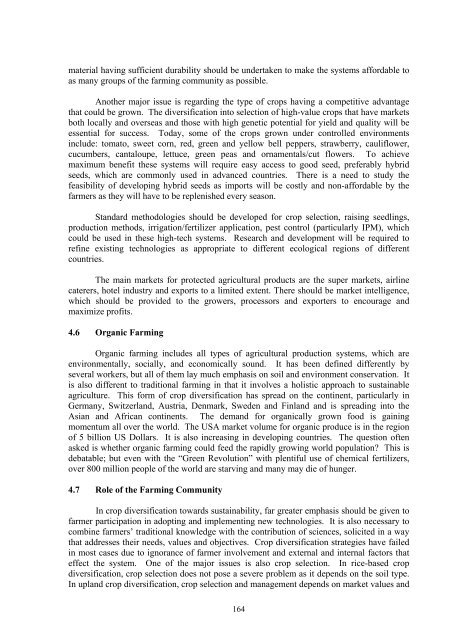Crop Diversification in the Asia-Pacific region - United Nations in ...
Crop Diversification in the Asia-Pacific region - United Nations in ...
Crop Diversification in the Asia-Pacific region - United Nations in ...
- No tags were found...
Create successful ePaper yourself
Turn your PDF publications into a flip-book with our unique Google optimized e-Paper software.
material hav<strong>in</strong>g sufficient durability should be undertaken to make <strong>the</strong> systems affordable toas many groups of <strong>the</strong> farm<strong>in</strong>g community as possible.Ano<strong>the</strong>r major issue is regard<strong>in</strong>g <strong>the</strong> type of crops hav<strong>in</strong>g a competitive advantagethat could be grown. The diversification <strong>in</strong>to selection of high-value crops that have marketsboth locally and overseas and those with high genetic potential for yield and quality will beessential for success. Today, some of <strong>the</strong> crops grown under controlled environments<strong>in</strong>clude: tomato, sweet corn, red, green and yellow bell peppers, strawberry, cauliflower,cucumbers, cantaloupe, lettuce, green peas and ornamentals/cut flowers. To achievemaximum benefit <strong>the</strong>se systems will require easy access to good seed, preferably hybridseeds, which are commonly used <strong>in</strong> advanced countries. There is a need to study <strong>the</strong>feasibility of develop<strong>in</strong>g hybrid seeds as imports will be costly and non-affordable by <strong>the</strong>farmers as <strong>the</strong>y will have to be replenished every season.Standard methodologies should be developed for crop selection, rais<strong>in</strong>g seedl<strong>in</strong>gs,production methods, irrigation/fertilizer application, pest control (particularly IPM), whichcould be used <strong>in</strong> <strong>the</strong>se high-tech systems. Research and development will be required toref<strong>in</strong>e exist<strong>in</strong>g technologies as appropriate to different ecological <strong>region</strong>s of differentcountries.The ma<strong>in</strong> markets for protected agricultural products are <strong>the</strong> super markets, airl<strong>in</strong>ecaterers, hotel <strong>in</strong>dustry and exports to a limited extent. There should be market <strong>in</strong>telligence,which should be provided to <strong>the</strong> growers, processors and exporters to encourage andmaximize profits.4.6 Organic Farm<strong>in</strong>gOrganic farm<strong>in</strong>g <strong>in</strong>cludes all types of agricultural production systems, which areenvironmentally, socially, and economically sound. It has been def<strong>in</strong>ed differently byseveral workers, but all of <strong>the</strong>m lay much emphasis on soil and environment conservation. Itis also different to traditional farm<strong>in</strong>g <strong>in</strong> that it <strong>in</strong>volves a holistic approach to susta<strong>in</strong>ableagriculture. This form of crop diversification has spread on <strong>the</strong> cont<strong>in</strong>ent, particularly <strong>in</strong>Germany, Switzerland, Austria, Denmark, Sweden and F<strong>in</strong>land and is spread<strong>in</strong>g <strong>in</strong>to <strong>the</strong><strong>Asia</strong>n and African cont<strong>in</strong>ents. The demand for organically grown food is ga<strong>in</strong><strong>in</strong>gmomentum all over <strong>the</strong> world. The USA market volume for organic produce is <strong>in</strong> <strong>the</strong> <strong>region</strong>of 5 billion US Dollars. It is also <strong>in</strong>creas<strong>in</strong>g <strong>in</strong> develop<strong>in</strong>g countries. The question oftenasked is whe<strong>the</strong>r organic farm<strong>in</strong>g could feed <strong>the</strong> rapidly grow<strong>in</strong>g world population? This isdebatable; but even with <strong>the</strong> “Green Revolution” with plentiful use of chemical fertilizers,over 800 million people of <strong>the</strong> world are starv<strong>in</strong>g and many may die of hunger.4.7 Role of <strong>the</strong> Farm<strong>in</strong>g CommunityIn crop diversification towards susta<strong>in</strong>ability, far greater emphasis should be given tofarmer participation <strong>in</strong> adopt<strong>in</strong>g and implement<strong>in</strong>g new technologies. It is also necessary tocomb<strong>in</strong>e farmers’ traditional knowledge with <strong>the</strong> contribution of sciences, solicited <strong>in</strong> a waythat addresses <strong>the</strong>ir needs, values and objectives. <strong>Crop</strong> diversification strategies have failed<strong>in</strong> most cases due to ignorance of farmer <strong>in</strong>volvement and external and <strong>in</strong>ternal factors thateffect <strong>the</strong> system. One of <strong>the</strong> major issues is also crop selection. In rice-based cropdiversification, crop selection does not pose a severe problem as it depends on <strong>the</strong> soil type.In upland crop diversification, crop selection and management depends on market values and164
















